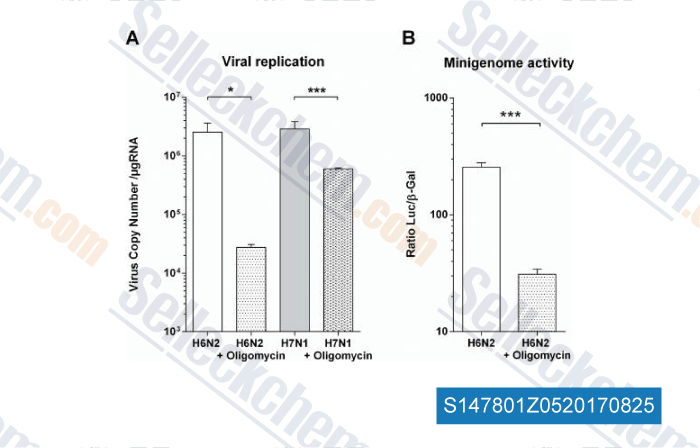|
Toll Free: (877) 796-6397 -- USA and Canada only -- |
Fax: +1-832-582-8590 Orders: +1-832-582-8158 |
Tech Support: +1-832-582-8158 Ext:3 Please provide your Order Number in the email. |
Technical Data
| Formula | C45H74O11 |
|||
| Molecular Weight | 791.06 | CAS No. | 579-13-5 | |
| Solubility (25°C)* | In vitro | DMSO | 100 mg/mL (126.41 mM) | |
| Water | Insoluble | |||
| Ethanol | Insoluble | |||
|
* <1 mg/ml means slightly soluble or insoluble. * Please note that Selleck tests the solubility of all compounds in-house, and the actual solubility may differ slightly from published values. This is normal and is due to slight batch-to-batch variations. * Room temperature shipping (Stability testing shows this product can be shipped without any cooling measures.) |
||||
Preparing Stock Solutions
Biological Activity
| Description | Oligomycin A (MCH 32), a dominant analog of the isomers, is an inhibitor of mitochondrial F1FO ATP synthase which inhibits oxidative phosphorylation and all the ATP-dependent processes occurring on the coupling membrane of mitochondria. It inhibits ATP synthase by blocking its proton channel (Fo subunit), which is necessary for oxidative phosphorylation of ADP to ATP. It also induces apoptosis in a variety of cell types. | |
|---|---|---|
| Targets |
|
|
| In vitro | Oligomycin A is an inhibitor of ATP synthase, inhibits oxidative phosphorylation and all the ATP-dependent processes occurring on the coupling membrane of mitochondria.Oligomycin A inhibits ATP synthase by blocking its proton channel (Fo subunit), which is necessary for oxidative phosphorylation of ADP to ATP. The inhibition of ATP synthesis by oligomycin A will significantly reduce electron flow through the electron transport chain; however, electron flow is not stopped completely due to a process known as proton leak or mitochondrial uncoupling. [1] In a group of cancer cells, Oligomycin at 100 ng/ml completely inhibits oxidative phosphorylation activity in 1 h and induces various levels of glycolysis gains by 6 h. [2] Oligomycin, inhibitor of the F0 part of H+-ATP-synthase, suppresses the TNF-induced apoptosis. [3] Oligomycin inhibits mitochondrial respiration in melanoma, sensitizes melanoma cells to therapy, blocks the emergence of the slow-cycling, long-term tumor-maintaining melanoma cells. [4] |
|
| In vivo | Oligomycin A (MCH 32) is an inhibitor of mitochondrial F0F1-ATPase. |
Protocol (from reference)
| Cell Assay: |
|
|---|---|
| Animal Study: |
|
References
Customer Product Validation

-
Data from [Data independently produced by , , Sci Rep, 2016, 6:24641.]

-
Data from [Data independently produced by , , Int J Oncol, 2018, 53(6):2590-2604]

-
Data from [Data independently produced by , , PLoS One, 2017, 12(4):e0176355]
Selleck's Oligomycin A has been cited by 113 publications
| Mitochondrial-cytochrome c oxidase II promotes glutaminolysis to sustain tumor cell survival upon glucose deprivation [ Nat Commun, 2025, 16(1):212] | PubMed: 39747079 |
| Aberrant activation of adenine nucleotide translocase 3 promotes progression and chemoresistance in multiple myeloma dependent on PINK1 transport [ Int J Biol Sci, 2025, 21(1):233-250] | PubMed: 39744418 |
| Non-canonical hepatic androgen receptor mediates glucagon sensitivity in female mice through the PGC1α/ERRα/mitochondria axis [ Cell Rep, 2025, 44(1):115188] | PubMed: 39792556 |
| PEBP1 amplifies mitochondrial dysfunction-induced integrated stress response [ Elife, 2025, 13RP102852] | PubMed: 39878441 |
| Autophagic flux-lipid droplet biogenesis cascade sustains mitochondrial fitness in colorectal cancer cells adapted to acidosis [ Cell Death Discov, 2025, 11(1):21] | PubMed: 39856069 |
| TGF-β secreted by cancer cells-platelets interaction activates cancer metastasis potential by inducing metabolic reprogramming and bioenergetic adaptation [ J Cancer, 2025, 16(4):1310-1323] | PubMed: 39895802 |
| AKT1 phosphorylation of cytoplasmic ME2 induces a metabolic switch to glycolysis for tumorigenesis [ Nat Commun, 2024, 15(1):686] | PubMed: 38263319 |
| Spautin-1 promotes PINK1-PRKN-dependent mitophagy and improves associative learning capability in an alzheimer disease animal model [ Autophagy, 2024, 1-22.] | PubMed: 39051473 |
| Adenosine diphosphate released from stressed cells triggers mitochondrial transfer to achieve tissue homeostasis [ PLoS Biol, 2024, 22(8):e3002753] | PubMed: 39163396 |
| IL-27 disturbs lipid metabolism and restrains mitochondrial activity to inhibit γδ T17 cell-mediated skin inflammation [ Cell Death Dis, 2024, 15(7):491] | PubMed: 38982043 |
RETURN POLICY
Selleck Chemical’s Unconditional Return Policy ensures a smooth online shopping experience for our customers. If you are in any way unsatisfied with your purchase, you may return any item(s) within 7 days of receiving it. In the event of product quality issues, either protocol related or product related problems, you may return any item(s) within 365 days from the original purchase date. Please follow the instructions below when returning products.
SHIPPING AND STORAGE
Selleck products are transported at room temperature. If you receive the product at room temperature, please rest assured, the Selleck Quality Inspection Department has conducted experiments to verify that the normal temperature placement of one month will not affect the biological activity of powder products. After collecting, please store the product according to the requirements described in the datasheet. Most Selleck products are stable under the recommended conditions.
NOT FOR HUMAN, VETERINARY DIAGNOSTIC OR THERAPEUTIC USE.
